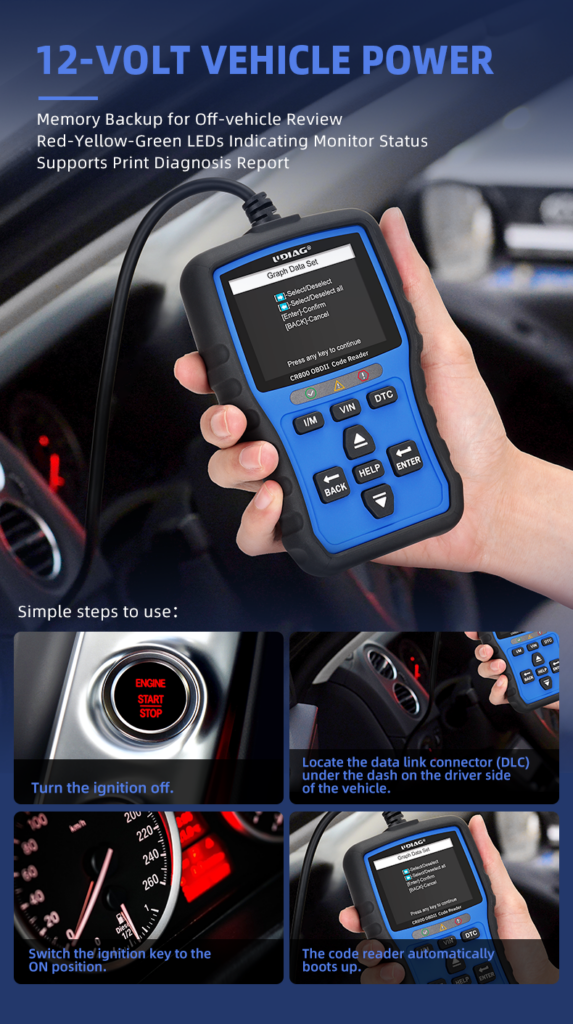For car maintenance, are all OBDII Code Reader the same?
2023-12-14 by UDIAG
The world of automotive diagnostics has witnessed a significant transformation with the advent of On-Board Diagnostics II (OBDII) Code Readers. These devices play a crucial role in car maintenance by providing valuable insights into a vehicle’s health through the interpretation of Diagnostic Trouble Codes (DTCs). However, not all OBDII Code Readers are created equal, and understanding the nuances of their variations is essential for making informed decisions about their selection.

I. Basic Functions of OBDII Code Readers
OBDII Code Readers serve as the bridge between a car’s internal computer system and the user, offering several fundamental functions. These include reading and clearing DTCs, accessing freeze frame data, O2 sensor testing, on-board monitoring, and retrieving essential vehicle information. These functions are the foundation of effective car maintenance, allowing users to identify and address issues promptly.
II. Factors Influencing OBDII Code Reader Variability
The diversity among OBDII Code Readers stems from various factors. Compatibility with different vehicle makes and models, communication protocols (such as CAN, J1850, and ISO9141), wired vs. wireless connectivity, display and user interface design, and additional features like live data and ABS testing contribute to the variability. It is crucial to understand these factors to choose a device that aligns with specific needs and preferences.
III. Types of OBDII Code Readers
OBDII Code Readers can be broadly categorized into basic and advanced types, each catering to different user requirements. Basic Code Readers offer limited functionality and are ideal for those seeking an affordable option for basic diagnostics. Advanced Code Readers, on the other hand, provide enhanced diagnostic capabilities, live data analysis, and graphing features, making them suitable for professionals and enthusiasts alike. Additionally, Bluetooth and Wi-Fi OBDII Code Readers offer wireless connectivity, often compatible with smartphone apps for a more convenient user experience.
IV. Considerations for Choosing an OBDII Code Reader
Selecting the right OBDII Code Reader involves careful consideration of several factors. User skill level, the purpose of use (DIY, professional, etc.), budget constraints, updateability, and compatibility with specific vehicles are all crucial elements. User reviews and recommendations also play a vital role in guiding potential buyers toward a device that meets their unique requirements.
V. Common Challenges and Limitations
Despite their significant benefits, OBDII Code Readers come with certain challenges and limitations. These include limited compatibility with certain vehicles, variations in code definitions, a learning curve for beginners, and the potential for false positives and negatives. Acknowledging these challenges allows users to approach car diagnostics with a realistic understanding of the tool’s capabilities.
Conclusion
In conclusion, OBDII Code Readers are indispensable tools for car maintenance, providing users with the ability to diagnose and address issues proactively. However, the diversity in these devices necessitates careful consideration before making a purchase. By understanding the basic functions, variability factors, types, considerations for selection, and potential challenges, users can navigate the market more effectively and ensure they invest in an OBDII Code Reader that aligns with their specific needs and preferences. Regular car maintenance, empowered by these diagnostic tools, contributes to the longevity and optimal performance of vehicles, emphasizing the importance of informed decision-making in the realm of automotive diagnostics.
Get Access Now: https://www.udiagtech.com
FAQs
1. What is an OBDII Code Reader, and why is it important for car maintenance?
An OBDII Code Reader is a device that interfaces with a vehicle’s on-board computer system to retrieve and interpret Diagnostic Trouble Codes (DTCs). It is essential for car maintenance as it helps users identify and address issues, contributing to the overall health and performance of the vehicle.
2. How do OBDII Code Readers work, and what basic functions do they perform?
OBDII Code Readers work by connecting to a car’s OBDII port and accessing the on-board computer system. Their basic functions include reading and clearing DTCs, accessing freeze frame data, O2 sensor testing, on-board monitoring, and retrieving vital vehicle information.
3. Are all OBDII Code Readers the same, or do they vary in functionality?
OBDII Code Readers vary significantly in functionality. Basic models offer limited diagnostic capabilities, while advanced models provide enhanced features such as live data analysis and graphing. The choice depends on user needs, skill level, and budget.
4. What factors should I consider when choosing an OBDII Code Reader for my vehicle?
Consider compatibility with your vehicle make and model, communication protocols, wired vs. wireless connectivity, display and user interface, additional features, user skill level, purpose of use, budget constraints, and the device’s updateability.
5. Are OBDII Code Readers compatible with all vehicles?
Compatibility varies among OBDII Code Readers. It is crucial to check whether a specific device supports your vehicle’s make, model, and year before making a purchase.


